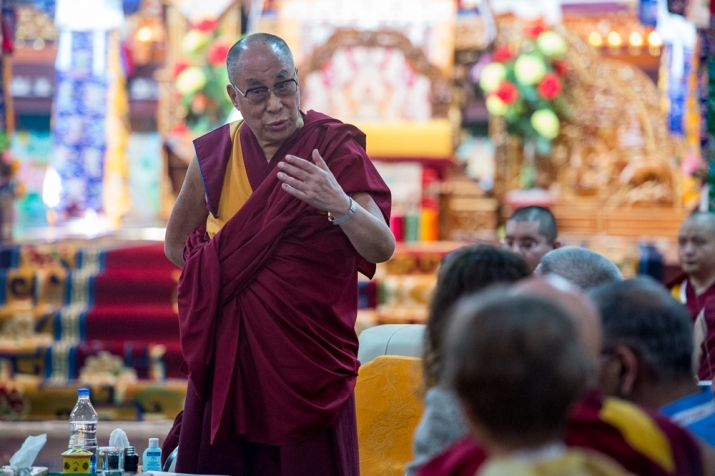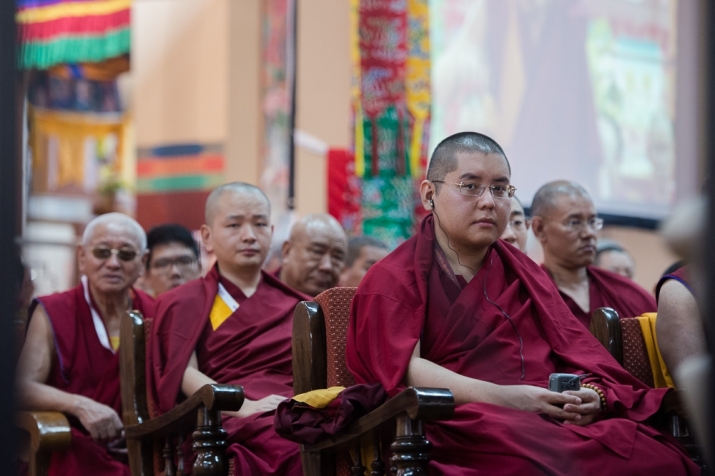NEWS
Dalai Lama Opens the First Session of the 30th Mind & Life Institute Dialogue
 His Holiness the Dalai Lama delivers his opening remarks at the start of the conference at Sera Monastery. Photo by Tenzin Choejor. From dalailama.com
His Holiness the Dalai Lama delivers his opening remarks at the start of the conference at Sera Monastery. Photo by Tenzin Choejor. From dalailama.comHis Holiness the Dalai Lama on Monday opened the first day of the Mind & Life Institute’s 30th dialogue between modern science and Buddhist science. The conference, which runs from 14–17 December at Sera Monastery in Bylakuppe, near the southern Indian city of Mysuru (formerly Mysore), is focused on the topic “Perception, Concepts, and Self: Contemporary Scientific and Buddhist Perspectives.”
Each session of the conference is divided into several parts—mornings and early afternoons feature presentations and dialogues between His Holiness and scientists, followed by question-and-answer sessions and general discussion between the audience and the presenters. Evenings are reserved for special presentations and scientific demonstrations. The first day, moderated by Zen Buddhist teacher Roshi Joan Halifax, was attended by members of the institute and senior lamas, as well as hundreds of monastics and other interested people.
In his opening address, the Dalai Lama observed: “Since many of you monks are new to this, let me tell you about how the Mind & Life Institute came about and evolved. Thirty years ago I had a wish to have in-depth discussions with scientists. I’d been interested in science since I was a child in Tibet. I thought it would be good if I were able to meet with scientists in person. And when I did, I was struck by how unbiased they were. Our subsequent discussions were mutually beneficial. I discovered that those of us who come from the Nalanda tradition were able to learn from them about matter and the material world, but that they too could learn from us about the mind.”
“Two years ago we held a Mind & Life meeting at Drepung Monastery and one of the questions that arose then was whether Buddhist logic and debate could be applied to other topics,” His Holiness said. “Since then its use has grown in Tibetan schools and across the Himalayan region. It is used to examine and explore science without any religious connotation. Nevertheless, we are looking for ways to help the 7 billion human beings in the world.”
 Senior monks listening to the presentations. Photo by Tenzin Choejor. From dalailama.com
Senior monks listening to the presentations. Photo by Tenzin Choejor. From dalailama.comThe first presentations focused on the perspective of Western science and philosophy on the constructive nature of cognition, the possible nature of pre-conceptual cognition, and different concepts of self. Richard Davidson, professor of psychology and psychiatry at the University of Wisconsin–Madison, delved into the model of top-down perception, where the brain predominates, and bottom-up perception, in which sensory inputs predominate. Jay Garfield, professor of philosophy at the National University of Singapore, Yale University, the University of Melbourne, and the Central University of Tibetan Studies, explored the peculiarly human idea of a narrative self—the story we tell ourselves about who we are.
Buddhist scholar Thupten Jinpa Langri, who has been the Dalai Lama’s principal English translator since 1985, gave the day’s second presentation on theories of perception in Buddhist epistemology under the title “Does our Perception Mirror Reality?”
Jinpa observed that Buddhist epistemology stemmed from the Abhidharma doctrinal texts of the 3rd–1st centuries BCE, and was later developed in the work of the Indian Buddhist scholar Dignaga (c. 480–540), whose disciple Dharmakirti composed seven definitive works on the subject. Dignaga, Jinpa explained, defined perception as arising from a convergence of object, sense faculty, and awareness and in terms of an absence of conceptuality such as associating names with the object. Dharmakirti developed this approach, defining perception as “cognition free of conceptuality and undistorted.” Both scholars viewed perception as relating to unique particulars that constitute the real world, said Jinpa, while conceptual cognition relates to general characteristics that are constructs of our own thought.
In the afternoon session, Pawan Sinha, professor of vision and computational neuroscience at Massachusetts Institute of Technology, described his success in “compassionate science”—merging the scientific quest for understanding with humanitarian need—achieved through a project he has established in India to restore sight in visually impaired children. Because the children had never used their eyes before, Sinha said, the project also offered an opportunity to gather valuable scientific data and research into how visual awareness develops in the brain.
The Mind & Life Institute is a US-registered, non-profit organization founded in 1990. It is committed to building a scientific understanding of the mind as a way to reduce suffering and to exploring the interface between science and Buddhism, and understanding the nature of reality. Its activities include convening international dialogues between scientists and contemplatives, publishing the outcomes, and setting up scientific research programs.
See more
Mind and Life XXX: Perception, Concepts, and Self (Mind & Life Institute)
Mind & Life XXX, Perceptions, Concepts and Self - Day 1 (His Holiness the 14th Dalai Lama of Tibet)
Live Webcasts: Mind & Life XXX - Perceptions, Concepts and Self (His Holiness the 14th Dalai Lama of Tibet)
Mind & Life Institute (Homepage)














